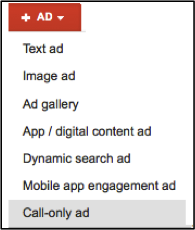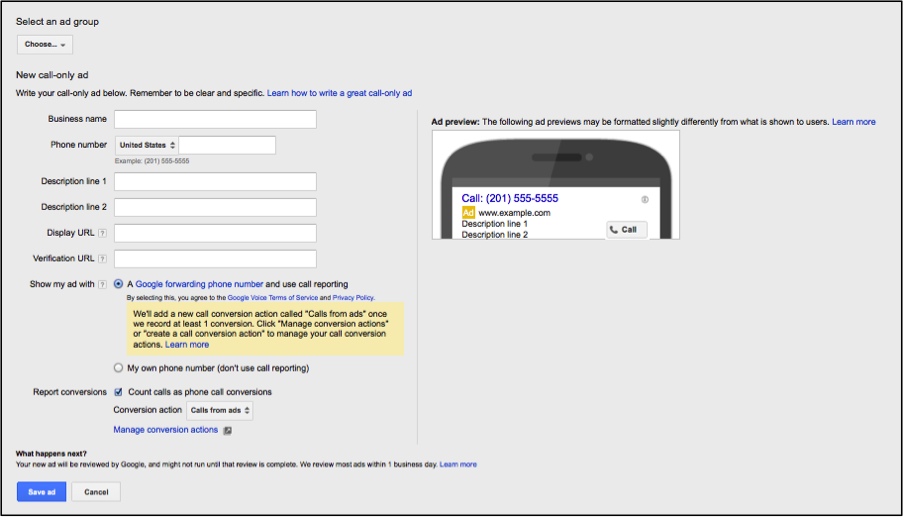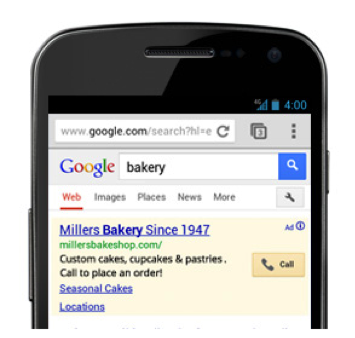The team at Google announced last week that they are rolling out a new campaign type entitled call-only campaigns. The ad type is aimed at mobile devices and work extremely well for advertisers who value a phone call more than a click. These ads can be set up directly from the ads tab in the Google interface.


Once you have chosen to create a call-only ad you will need to fill out the website URL and the phone number, along with the two description lines. Your ad will be charged when a user clicks. When the user clicks, the phone number will load and prompt a call using the users phone. This ad will not result in a visit to the website.
Prior to Google rolling out call-only ads, advertisers had to use the call extension feature in ads. These ads had a similar feature enabling the phone number to be dialed with the click of the “call” button from the mobile search results page. The downside of these ads was that the user could also click thru to the website. We found working with advertisers that this extension gave way to a lot of accidental clicks to the website as well as accidental phone calls.

The hope is that the new call-only ad type will reduce these accidental clicks and calls. I believe the CPCs may also be cheaper especially before most advertisers start to embrace this ad type.
One item I find particularly interesting about this new feature is that at the most basic level it is an opportunity for advertisers who do not have a mobile friendly website to spend money on mobile advertising. We all know more searches this year than ever are being performed on mobile devices. An important distinction to make is that just because a business has a mobile friendly site, it does not mean that the mobile site converts well. I just completed a large mobile audit of one of our clients and took note the conversion rates for this particular client. Unfortunately, based on the data my recommendation to the team was to be more restrictive on mobile bids because the conversion rates are not keeping up with the impressions and clicks.
Here are several creative reasons why you may want to consider a call-only advertising type for your ads today.
Customer Service
There are many times when customers need to call instead of visit a website. Unfortunately, most of the time when a customer needs to call it is because of a specific question, issue, or problem. The strongest, most customer service centric brands know that these points of engagement with the customer are crucial to long term retention. The call-only feature is a great way to ensure this touch-point is smooth. Consider creating an ad group for branded keywords that are modified with terms such as:
- Contact
- Address
- Phone number
- Service
And so on and sending these keywords to this type of ad.
High-End Travel Industry
While most people are comfortable booking hotels and vacations online there is certainly comfort in calling. Potential prospects booking expensive trips still feel a phone call is necessary to get the best rate. This ad type is a great fit for the travel industry.
The Mobile Experience
Some brands simply need to collect more information than a simple form allows. While mobile devices are getting larger and size and consumers are more comfortable filling out forms online, there is still a percentage of the population that finds a phone call to be easier. Many websites are optimized for mobile traffic and still do not convert well as explained above. Making the assumption that since a site is mobile friendly, therefore it should convert well, is simply not true. This new functionality reduces the sales path and supports potential customers with a quick call directly to a business. Because the potential customer can’t click through to the website, your team will have the chance to be the first touch point to impact the conversion.
Quality of the Customer
If a prospect makes a phone call to a business, there is a certain level of engagement that can be assumed. Your business can look at metrics such as call quantity, call length, time of the phone call, and call location. The PPC team is able to track performance and make optimizations using this call data.
Target Market
While mobile adoption rates among seniors are still high, many traditional customers still feel more comfortable doing business over the phone. This is not always because of habit or comfort, but sometimes it is due to eyesight. As large and clear as mobile phone screens are becoming they are still a known challenge when wearing bifocals. If your brand is highly aware of your target market making this adjustment and alignment with your potential customers is a smart business decision.
Conclusion
If phone calls are the essence of your business, call-only ads can help your business reach for increased lead generation and ROI in your account. While sources site the growth of mobile, there is still true value to human interaction with businesses. Much like other AdWords features we recommend, take the time to create distinct campaign and ad groups so you can funnel the correct queries and device searches to the correct ads.



